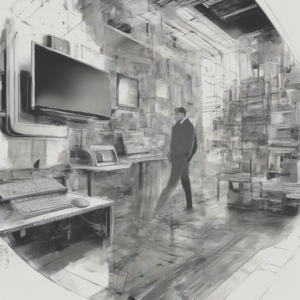Revolutionizing Tomorrow: A Deep Dive into the Future of Pipe Industries
The pipe industry, a cornerstone of infrastructure development for centuries, stands on the cusp of a transformative era. Driven by technological advancements, evolving environmental concerns, and shifting global demands, the future of pipe industries promises a radical departure from traditional methods and materials. This exploration delves into the key trends shaping this evolution, examining innovative materials, manufacturing processes, and applications that will redefine the landscape of pipe infrastructure.
1. Smart Pipes and the Internet of Things (IoT)
The integration of smart technology is revolutionizing pipe infrastructure. Smart pipes, embedded with sensors and connected to the IoT, enable real-time monitoring of pressure, flow rates, temperature, and leaks. This data-driven approach offers unprecedented levels of efficiency and safety. Predictive maintenance becomes possible, allowing for timely repairs and preventing costly disruptions. Leaks can be detected and addressed before they escalate into major incidents, minimizing environmental damage and economic losses.
- Real-time monitoring: Sensors provide continuous data on pipe performance.
- Predictive maintenance: Data analysis allows for proactive repairs, extending pipe lifespan.
- Leak detection: Early identification of leaks minimizes water waste and environmental impact.
- Improved efficiency: Optimized flow management reduces energy consumption and operating costs.
- Enhanced safety: Early warning systems prevent catastrophic failures and protect surrounding infrastructure.
2. Advanced Materials: Beyond Traditional Steel and PVC
The limitations of traditional pipe materials, such as susceptibility to corrosion, degradation, and high installation costs, are driving the exploration of innovative alternatives. Advanced materials are emerging as key players in shaping the future of pipe industries. These include:
- High-Density Polyethylene (HDPE): Lightweight, durable, and resistant to corrosion, HDPE pipes offer a cost-effective and environmentally friendly solution for various applications.
- Fiber-Reinforced Polymers (FRP): Combining the strength of fibers with the lightweight properties of polymers, FRP pipes offer high strength-to-weight ratios, making them suitable for challenging environments.
- Ductile Iron: Offering superior strength and durability compared to traditional cast iron, ductile iron pipes provide long-lasting and reliable infrastructure.
- Carbon Fiber Reinforced Polymers (CFRP): Exceptional strength and lightweight characteristics make CFRP pipes ideal for applications demanding high performance and minimal weight.
- Smart Materials: Materials with self-healing capabilities and embedded sensors are being developed to further enhance pipe performance and longevity.
3. Sustainable and Eco-Friendly Practices
Environmental concerns are increasingly influencing the pipe industry. The focus is shifting towards sustainable practices, encompassing material selection, manufacturing processes, and end-of-life management. The use of recycled materials, reduced energy consumption during manufacturing, and the development of biodegradable or recyclable pipes are crucial aspects of this transformation.
- Recycled materials: Incorporating recycled plastics and metals into pipe manufacturing reduces reliance on virgin resources.
- Reduced energy consumption: Optimizing manufacturing processes to minimize energy usage lowers carbon footprint.
- Biodegradable pipes: Research into biodegradable polymers offers a sustainable solution for temporary or specialized applications.
- Recyclable pipes: Designing pipes for easy dismantling and recycling extends the lifecycle of materials.
- Reduced water waste: Leak detection and prevention technologies minimize water loss, contributing to conservation efforts.
4. 3D Printing and Additive Manufacturing
Additive manufacturing, or 3D printing, is emerging as a game-changer in pipe production. This technology enables the creation of complex pipe geometries and customized designs that would be impossible with traditional manufacturing methods. 3D printing also offers greater flexibility in material selection and the ability to produce pipes on-site, reducing transportation costs and time.
- Customized designs: 3D printing allows for the creation of pipes tailored to specific applications and requirements.
- Complex geometries: Creating intricate shapes and internal structures improves pipe performance and efficiency.
- On-site manufacturing: Reduces transportation costs and time, especially beneficial in remote locations.
- Material flexibility: Enables the use of a wider range of materials, including those with specialized properties.
- Reduced waste: Additive manufacturing minimizes material waste compared to traditional subtractive methods.
5. Robotics and Automation in Pipe Installation and Repair
The integration of robotics and automation is streamlining pipe installation and repair processes, improving safety, efficiency, and reducing labor costs. Robotic systems can handle tasks in hazardous environments, perform complex repairs with precision, and work autonomously, reducing the need for human intervention in dangerous or challenging situations.
- Improved safety: Robots perform tasks in hazardous environments, minimizing risks to human workers.
- Enhanced efficiency: Automation speeds up installation and repair processes, reducing project timelines.
- Reduced labor costs: Automation reduces reliance on manual labor, lowering overall project costs.
- Increased precision: Robots perform tasks with higher accuracy and consistency compared to manual methods.
- Remote operation: Robotic systems can be controlled remotely, enabling repairs in inaccessible locations.
6. Advanced Inspection and Maintenance Technologies
Non-destructive testing (NDT) methods, such as ultrasonic testing, radiographic testing, and electromagnetic testing, play a crucial role in ensuring the integrity of pipe infrastructure. Advanced NDT technologies, coupled with data analysis and machine learning, provide more accurate and efficient pipe inspection and maintenance strategies. This leads to improved safety and reduced downtime.
- Improved accuracy: Advanced NDT techniques provide more precise identification of defects and weaknesses.
- Enhanced efficiency: Automated inspection systems speed up the inspection process, minimizing downtime.
- Predictive maintenance: Data analysis of inspection results enables proactive maintenance, preventing failures.
- Reduced downtime: Early detection of defects minimizes disruptions to service and reduces repair costs.
- Data-driven decision making: Data analysis informs optimal maintenance strategies, maximizing efficiency and safety.
7. The Role of Big Data and Artificial Intelligence
The vast amounts of data generated by smart pipes and advanced inspection technologies can be leveraged using big data analytics and artificial intelligence (AI). AI algorithms can analyze this data to predict pipe failures, optimize maintenance schedules, and improve overall infrastructure management. This data-driven approach enhances efficiency, reduces costs, and improves the resilience of pipe networks.
- Predictive maintenance: AI algorithms predict potential failures based on data analysis, enabling proactive maintenance.
- Optimized maintenance scheduling: AI helps optimize maintenance schedules, minimizing disruptions and maximizing efficiency.
- Improved resource allocation: Data analysis guides efficient resource allocation for maintenance and repairs.
- Enhanced decision-making: Data-driven insights inform better decisions related to pipe infrastructure management.
- Risk assessment and mitigation: AI can identify and assess risks, enabling proactive mitigation strategies.
8. New Applications and Expanding Markets
The advancements in pipe technology are expanding the applications of pipes beyond traditional uses. New applications include:
- Energy transmission: High-performance pipes for transporting oil, gas, and other energy resources.
- Water management: Smart pipes for efficient water distribution and leak prevention.
- Wastewater treatment: Advanced pipes for managing and treating wastewater effectively.
- Industrial processes: Specialized pipes for transporting chemicals and other industrial fluids.
- Infrastructure development: Pipes for use in building construction, road networks, and other infrastructure projects.
9. Challenges and Future Directions
Despite the promising advancements, the future of pipe industries faces several challenges. These include the high initial cost of implementing new technologies, the need for skilled workforce training, and the standardization of new materials and manufacturing processes. Addressing these challenges requires collaboration between industry stakeholders, researchers, and policymakers.
- Cost of implementation: High initial investment in new technologies can be a barrier for adoption.
- Workforce training: Skilled labor is needed to operate and maintain new technologies.
- Standardization: Establishing standards for new materials and manufacturing processes is essential.
- Interoperability: Ensuring seamless integration between different technologies and systems.
- Regulation and policy: Supportive regulatory frameworks are crucial for fostering innovation and adoption.




